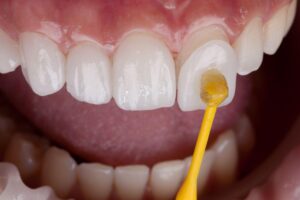Are you considering a crown on front tooth to restore your dazzling smile? Understanding the procedure, materials, and alternatives can help you make an informed decision. In this blog post, we will explore everything you need to know about front dental crown, from the types of materials used to the procedure itself, cost, and how to care for your new crown.
Key Takeaways
- Front tooth crowns are a cosmetic dentistry option for restoring weak, broken or decayed teeth.
- Different materials such as porcelain, ceramic and zirconia can be used to create the crowns. Metal is not suitable for front teeth due to its lack of natural appearance.
- The cost of a front tooth crown may be covered by insurance with proper discussion between dentist and provider. Good oral hygiene will ensure longevity.
Understanding Front Tooth Crowns
Front tooth crowns are an integral part of cosmetic dentistry, as they restore weak, broken, or decayed teeth. When choosing a dental crown on front teeth, it’s important to consider aesthetics, longevity, and expense. These tooth-shaped caps offer numerous advantages, such as restoring tooth structure, function, and aesthetics, as well as providing a cost-effective solution for tooth repair, regardless of the material used.
Tooth decay can lead to significant damage, and in such cases, crowns may be recommended to restore the tooth. What exactly is a front tooth crown, and what reasons might persuade you to choose one? We’re going to explore this in depth.
What is a Front Tooth Crown?
A front tooth crown, also called a front tooth cap, is a tooth-shaped covering that is placed over a damaged or decayed front tooth to restore its structure and aesthetic. It is commonly manufactured using porcelain or ceramic to provide a natural-looking result. A front tooth cap enhances both function and appearance. These crowns offer a protective covering for natural teeth, especially for patients who grind or clench their teeth.
However, front tooth crowns have some drawbacks:
- They require considerable tooth reduction, meaning a portion of the natural tooth must be eliminated to accommodate the crown.
- They may not be suitable for patients with minimal tooth damage or those seeking less invasive treatment options.
- Alternative solutions like veneers or dental bonding might be more appropriate for these patients.
Why Choose a Front Tooth Crown?
The recommendation for a front tooth crown may depend on the particular situation or the extent of the damage, and the dental crown procedure will be tailored accordingly. Front tooth crowns offer numerous advantages, such as:
- Safeguarding against additional damage
- Diminished sensitivity
- Enhanced appearance of the tooth
- Enhanced chewing and speaking
- Long-term sturdiness
All of these advantages can justify the dental crown cost.
Choosing a front tooth crown means investing in a solution that is both durable and aesthetically pleasing, effectively restoring your smile and boosting your confidence in your appearance.
Types of Dental Crowns for Front Teeth
There are different materials available for front tooth crowns, each with its own set of advantages. This section explores the different materials used for front tooth crowns – porcelain and ceramic crowns, zirconia crowns, and metal crowns – to help you make an informed decision about the material that suits your needs best.
Crowns are typically porcelain and ceramic crowns, which are the most popular choice for front teeth, as they have the best esthetics and strength.
Porcelain and Ceramic Crowns
Porcelain and ceramic crowns offer a natural appearance and are a popular choice for front teeth. Pressed ceramic crowns, for example, can be employed on both front and back teeth, providing versatility and a natural look. Zirconium dioxide is frequently employed for ceramic crowns, ensuring durability and longevity.
However, there are some disadvantages to consider. Ceramic layers can be prone to wear and tear over time. This can result in deterioration of the layers. Additionally, porcelain-fused-to-metal (PFM) crowns may reveal a metallic-colored line over time, reducing their aesthetic appeal. All-ceramic or zirconia crowns, on the other hand, possess greater translucency, enabling them to more closely imitate the natural appearance of teeth, making them more aesthetically pleasing than PFM crowns.
Zirconia Crowns
Zirconia crowns are a strong and durable option for front teeth. These crowns offer several benefits:
- They are highly resilient and can tolerate greater forces than other types of ceramic crowns, making them an ideal choice for individuals seeking a long-lasting solution.
- They are gentle on the opposing teeth, resulting in reduced enamel wear.
- The estimated duration of a zirconia crown on a front tooth can reach up to 30 years, making it a worthwhile investment for your dental health.
Opting for zirconia crowns allows you to reap the benefits of their strength, durability, and longevity, ensuring that your front teeth stay protected and functional for an extended period.
Metal Crowns
When discussing types of crowns, metal crowns, made from materials such as gold crowns, palladium, nickel, and chromium, are known for their strength and durability. They rarely chip or break, have the longest wear-life, necessitate minimal natural tooth enamel removal, and are able to withstand biting and chewing forces.
However, metal crowns are less common for front teeth due to their aesthetic, as they do not provide a natural appearance. Despite their strength and durability, you need to consider the overall appearance and whether a metal crown is in alignment with your aesthetic preferences.
Front Tooth Crown Procedure Explained
Having discussed the materials used for front tooth crowns, let’s move on to the step-by-step procedure of getting a front tooth crown. This will help you understand what to expect during each stage of the process and ensure you’re fully prepared for your dental appointments.
The first step is to have a consultation with your dentist. During this appointment, your dentist will evaluate your teeth and your cosmetic concerns.
Consultation and Tooth Preparation
During the initial appointment, your dentist will discuss options, such as the type, color, and shape of the crown, and prepare the tooth for the crown. Part of this preparation involves trimming the tooth; on average, approximately 30% of the tooth is trimmed during the front tooth crown procedure.
This appointment is key to deciding the best course of action and making sure your tooth is properly prepared for the crown. Be sure to ask any questions and express any concerns you may have at this stage.
Impressions and Temporary Crown
After preparing the tooth, your dentist will take impressions or models, possibly with the use of a dental scanner, of the original tooth to create a custom crown. In the meantime, a temporary crown will be placed over the tooth to protect it until the permanent crown is ready.
This temporary solution will help maintain the appearance and function of your tooth while the dental lab fabricates your custom dental crown, ensuring a seamless fit and optimal results.
Permanent Crown Placement
The final appointment involves:
- Placing the permanent crown
- Ensuring a proper fit
- Removing the temporary crown
- Bonding the permanent crown with dental cement
- Adjusting the bite as needed
- Polishing the crown for a perfect finish
A precise fit is essential to guarantee that the crown is securely affixed and does not induce any discomfort, as well as to prevent any harm to the adjacent teeth. This final step ensures your front tooth crown is both functional and aesthetically pleasing.
Front Tooth Crown Cost and Insurance Coverage
The cost of a front tooth crown can be influenced by several factors, including the insurance plan and the individual case. Dental crowns can cost in excess of $1,300. Most dental insurance companies typically offer some form of coverage for crowns, with some companies providing partial or full coverage.
You should discuss the cost of your front tooth crown with your dentist and insurance provider to get a clear understanding of the costs involved and any potential insurance coverage.
Caring for Your Front Tooth Crown
Proper maintenance and care are key to prolonging the life of front tooth crowns. To ensure proper care, follow these tips:
- Practice good oral hygiene by brushing and flossing regularly
- Avoid sticky and hard foods that can damage the crown
- Use a night guard if necessary to protect the crown from grinding or clenching
By following these tips, you can help maintain the longevity of your front tooth crowns.
Additionally, don’t forget the importance of regular check-ups and maintenance with your dentist. By taking proper care of your front tooth crown, you can enjoy its benefits for many years to come.
Front Tooth Crown Alternatives
While front tooth crowns provide a durable and pleasing solution for severely damaged teeth, less damaged teeth have alternative treatments available like veneers and dental bonding. Veneers are more suitable for minimal tooth damage and less invasive treatment, while dental bonding is used to rectify minor damage to the front teeth.
Though veneers are less robust than crowns and might need to be replaced after a few years, they require less upkeep and attention. Discussing these alternatives with your dentist is pivotal when deciding the best course of action for your specific dental situation.
Summary
In conclusion, front tooth crowns offer a durable and aesthetically pleasing solution to restore your smile. Crowns on front teeth are a popular choice for those seeking both function and beauty. By understanding the various materials, procedures, costs, and care involved, you can make an informed decision and ensure the best results for your dental health. Always consult with your dentist to explore all available options and determine the most suitable treatment for your unique situation. Remember, a beautiful and healthy smile is worth the investment.
Frequently Asked Questions
Can you do a crown on a front tooth?
Yes, you can do a crown on a front tooth. Dental crowns can help restore or create a beautiful smile if there is severe damage to the teeth, or if you want a more durable restoration option. Aesthetic reasons might make ceramic or zirconia crowns the preferred option.
Are front teeth crowns a good idea?
Front teeth crowns can restore severely damaged teeth, provide a protective barrier for natural teeth, and help improve self-confidence. They are an excellent option for correcting crooked teeth, strengthening weakened teeth, and providing a durable aesthetic result.
How long do crowns last on front teeth?
High-quality front teeth crowns can last up to thirty years or beyond, with porcelain or fused material surviving for five to fifteen years and metal crowns having a 20+ year lifespan. In many cases, dental porcelain crowns applied on the front tooth will last at least 15 years.
What is the difference between a front tooth crown and a veneer?
Front tooth crowns are used for more severe dental problems, while veneers are a less invasive option for minimal damage.
What materials are used for metal crowns?
Metal crowns are commonly constructed from gold, palladium, nickel, and chromium alloys.






